More than half of the adolescents in a study group of 196 young athletes had been diagnosed with growing pains, which may occur due to muscle overuse and structural abnormalities, among other reasons.
“Idiopathic musculoskeletal pain is highly prevalent among young athletes, and their adherence to a healthy diet is suboptimal, challenging the assumption that physically active children maintain well-balanced diets,” researchers from the University of Alicante, Kinetic Performance and Laboratorios Ordesa in Spain wrote in the journal Nutrients.
“These findings emphasize the importance of early nutritional education and preventive strategies to promote musculoskeletal health, enhance recovery and potentially reduce pain incidence in physically active youth.”
What are growing pains?
Growing pains are characterized as intermittent and frequent nonspecific musculoskeletal discomfort that affects the limbs but not the joints, typically occurring in the age range of 3 to 14.
Despite extensive research, the reasons that young people develop growing pains are unclear.
The current study notes multiple theories such as the growth theory, which proposes that bone growth triggers musculoskeletal impulses, more noticeable at night due to reduced external stimuli, and the fatigue theory, which attributes pain to muscle overuse and the accumulation of metabolic by-products.
The emotional theory suggests a psychosomatic origin, linking stress and anxiety to growing pains. Vitamin D deficiency, joint hypermobility and a lower pain threshold have also been proposed as factors contributing to the development of the pain.
The importance of nutrition
Performance nutritionist Dan Richardson told Nutraingredients that the study reflects what he sees on the ground at professional clubs.
“Musculoskeletal pain is definitely common in youth athletes, especially during rapid growth phases and when fueling doesn’t match training demands,” he said, noting that nutrition often gets overlooked.
Richardson emphasized the importance of adequate fueling and hydration, as well as sufficient protein intake and micronutrients such as calcium and vitamin D. He recommends collagen and vitamin C for tendon and joint issues and omega-3 fatty acids for reducing inflammation.
“It’s always food first, but a good quality whey or milk-based shake post-training can be really practical,” he said. “For plant-based athletes, a blend (e.g. pea, rice, soy) works well.”
He said he hears more pain issues from female athletes, particularly if they are not fueling adequately during growth spurts.
“That said, it’s often under-reported in males due to a ‘tough it out’ mindset,” he added.
Study details
The cross-sectional study collected data from 916 athletes between the ages of 8 and 17 from five sports clubs and academies in Alicante, Spain. Participants completed an online survey that assessed their demographics, pain types and adherence to the Mediterranean diet.
Self-reported pain was prevalent in 78.5% of children and 93.5% of adolescents, with nocturnal pain more frequent in younger girls. Although 32.6% of children and 51.9% of adolescents had received a formal diagnosis of growing pain, less than 14% reported using analgesics.
Participants without pain “showed overall healthier dietary patterns,” the researchers reported
However, those with pain showed higher adherence to the Mediterranean diet. The researchers noted that this finding contradicts previous studies in adults, underscoring the need for further research.
“Simultaneously, unhealthy dietary habits, such as fast-food consumption, skipping breakfast and frequent intake of industrial pastries or sweets, were also particularly prevalent among participants reporting pain,” the researchers wrote.
They acknowledged the limitations of the study methods and recommended that future research account for specific nutrients rather than general dietary quality.
Source: Nutrients 2025, 17(14), 2384. doi: 10.3390/nu17142384. “Growing Pains and Dietary Habits in Young Athletes: A Cross-Sectional Survey”. Authors: C. Elvira-Aaranda et al.




